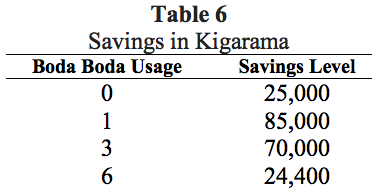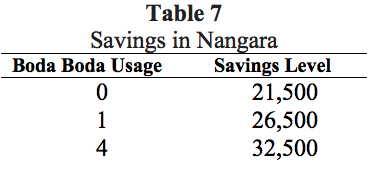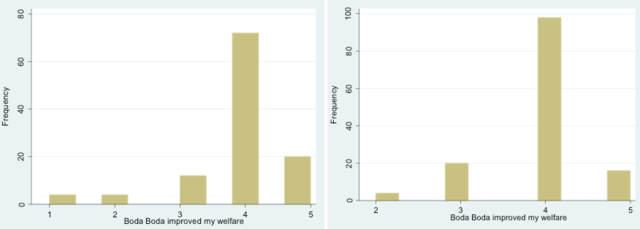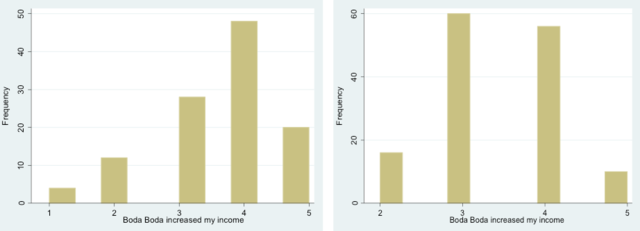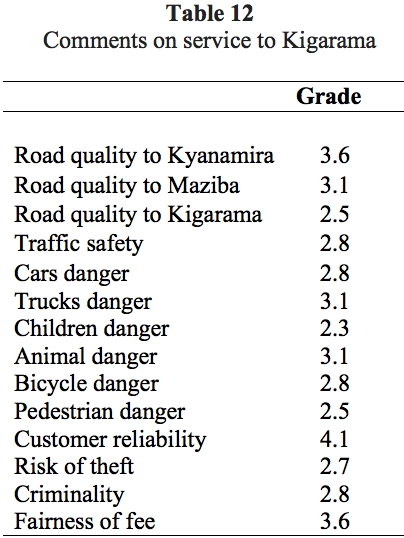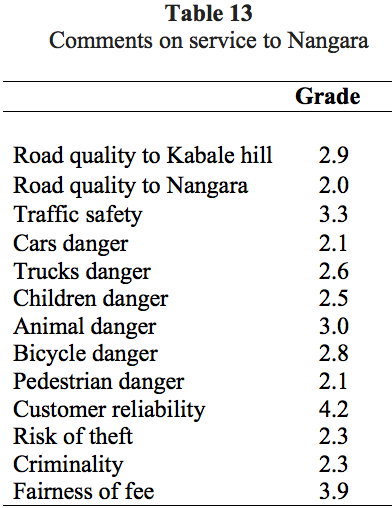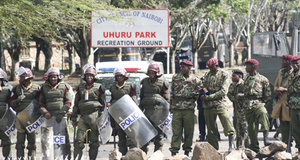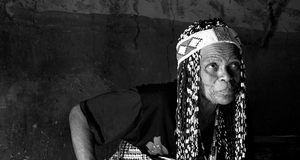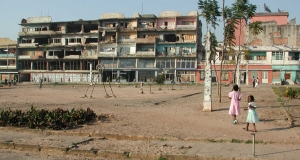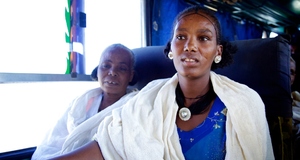From the FieldBoda Boda: The Impact of Motorbike Taxi Service in Rural Uganda5.3 Qualitative AnalysisAn analysis of the information provided by the questionnaires highlights interesting relationships between the socioeconomic factors examined in the study. The simple interaction among agricultural surplus, use of the Boda Boda, and the self-declared monthly savings level provides fodder for further discussions. It is acknowledged that the savings level of every household depends upon many factors like income, expenditures, health emergencies, random monetary shocks, inclement weather, etc. In the following table, however, I tried to found a correlation between the use of Boda Boda in specific circumstances and savings level. I was able to correlate the instances where an individual in the two villages was in possession of agricultural surplus, with the specific use of the Boda Boda for reaching the market with the purposes of buying and selling goods, and the personal savings level. The results, showed in the following tables suggest the hypothesis that the savings level of the remote rural households could be also influenced by a rational use of the Boda Boda.
The data for Nangara confirms that the transportation system might have a positive correlation with the savings level. It must be noticed that the village is closer to the market compared to Kigarama; it follows that the multiple use of the transportation mean does not imply an excessive monetary and time expenditure. This correlation appears to be consistent with the economic situation of the area; it requires, however, further investigations in order to assess the proper factors which affect the savings level. This study could not disregard a qualitative analysis of the factors affecting the population’s daily life and its welfare; those elements, as we will see, make it clear that the local concept of well-being is different from the conceptualization of well-being referred to in the United States or much of the Western Europe. The first observation stems from the fact that in these villages, social relations are a fundamental element ensuring an individual’s well-being. The survey shows how the Boda Boda’s are used by both sexes predominantly to facilitate social interaction.. The following table shows the results of the survey on the self-declared Boda Boda utilization in the village of Kigarama. Percentages refer to the proportion of the population which declared to use Boda Boda “always” or “most of the time” to reach the different locations. The data shows how the proportion of the population which uses Boda Boda for maintaining or creating social relations ( 51.72% ) is higher compared to a more business oriented utilization, (39.65%). Another striking factor is the scarce utilization of the Boda Boda service for accessing school (14.49%). The following table shows the results for the same survey about the self-declared Boda Boda utilization in the village of Nangara. The village of Nangara shows a higher percentage of the population using the Boda Boda to facilitate social interaction. This fact might be explained by its relatively closeness with Kabale city and subsequently to the road network thus allowing more options for interactions. The data regarding the self-declaration about the Boda Boda utilization to access school seems to be unreasonable. It would be appropriate to further investigate the finding since the village is provided with primary schools within walking distance. The analysis of this data shows how the Boda Boda service is perceived as a tool primarily to fulfill the needs for participation in the social life of the wider community and that being part of this community requires visits and contact with people outside of one’s home village. It is interesting to remark how the utilization of the service is scarce in terms of access to the western elements of welfare. The access to education is limited to the schools locally provided by the Government. It must be acknowledged that the primary schools, which are located close to many villages, even though are easily reachable on foot have scarce quality. The data shows that quality education is not the primary concern for remote rural families. This fact does not mean that the average family disregards the importance of education; the reality which has to be dealt with by development agencies is that in the poorest areas other priorities assume importance. A child has to be close to the village because he/she needs to work in the family garden, taking care of the herds, thus providing financial support to the family. The econometrics analysis I have performed in the previous pages has shown the same concept in regard to the access to health services. The increasing distance from the clinic is a negative factor for the willingness in using the Boda Boda. Time is considered a factor which cannot be diverted from more useful utilization like agricultural production which, rationally, is more valued than a visit to a clinic. The western world welfare concepts are thus not suitable for an accurate description of the usefulness of the Boda Boda transportation services. What appears crucial is the utilization of the service for the fulfillment of the need for social interaction. The construction of new social and community ties or the consolidation of previous ones is a key component of the rural population livelihoods. It is the fundamental form of insurance which allows the vulnerable populations to deal with the challenges caused by their socioeconomic status. The Boda Boda service provides an invaluable tool to permit the achievement of this goal. An important step in development, often overlooked, is the process of sharing villagers knowledge, ideas, and insight (Chambers 2008, p.87); this idea implies that an important question a researcher should ask regarding the impact of Boda Boda, is inquiring the citizens of Kigarama and Nangara their opinions about the service. The following graphs show the result of a survey probing for a subjective evaluation, in two villages, of the service provided with respect to the perceived increase in welfare and positive impact on personal income. Perception of welfare increase in Nangara (left) and Kigarama (right) The answers for the question regarding perceived well-being ranged from a 0 which meant absolute disagreement with the idea that Boda Boda services increase welfare, to a 5 which signified complete agreement with the statement. It is evident that the perception among the population is that the service is a fundamental element for their welfare. Perception of increased income in Nangara (left) and Kigarama (right) Even for graphs 3 and 4, the answers’ range followed the previous scale. In the case of easing the process of income generation, the answers show a more neutral opinion about the real impact of the taxi service. The results are, however, strikingly similar among the two villages. The framework appears clear. Isolation is a problem which impacts the ability of the remote population to have access to the network of opportunities they decide it is worth to connect with. In the case of the rural south Uganda, opportunities are the social interactions with the broader community. It should not be surprising that the access to the market is searched only in the case of concrete opportunities to increase personal income. The “market” is just a tool for achieving personal freedom, is not freedom. Rural populations need an instrument which allows them to construct their future at their own terms in their own areas. Boda Boda seems to meet the first requirement for their search for freedom. Boda Boda allows remote rural population to have access to the mobility they deem necessary for their welfare. 5.4 Boda Boda DriversThe analysis of the impact of the Boda Boda services on the remote rural population of Kabale district cannot be accurate without a deeper understanding of the motorbikes drivers’ individual characteristics. The results of a demographic survey performed before the beginning of the study did not show significant differences compared to the studies already published on the subject. A summary of the results is shown in the following table.
The job is reserved to only male drivers, and only a few of them have completed primary school. Another consideration that emerges from the study on the drivers of Kabale is the substantially equal net gain for both the Boda Boda that cover the two villages (137,825 UGX), and for the ones who do not (136,208 UGX). It is reasonable to assume that drivers and their association have been able to self-organize by dividing the territory. It is therefore logical to assume that a group of Boda Boda serves the Kigarama and Nangara while other groups serve other villages. This reasoning is backed up by the difference between the fees requested for urban and extra urban trips which are the same for every driver (1,525 UGX/Km for the city and 2,156 UGX/Km for rural trips). Finally, it must be noted how the Boda Boda job is a demanding activity in terms of physical effort, road dangers, and criminality. The following table shows a snapshot on the Kabale Boda Boda driver job characteristics.
The following two tables show the results of a survey among the Kabale drivers inquiring for their opinions regarding the service to Kigarama and Nangara. Every individual was asked to comment on various statements with the possibility of giving answers ranging from 1 (strongly disagree or very poor conditions) to 5 (strongly agree or exceptional quality).
A qualitative evaluation of the above results shows the drivers’ positive opinion regarding their relationship with their customers, which implies their immediate availability to provide the rural services. It is also remarkable how the drivers’ perception of the roads infrastructure does not correspond to international standards. The Boda Boda drivers state little concern regarding the roads situation and this fact should be further analyzed when planning future investment policies. The Boda Boda transportation system, still suffers from organizational problems. 20 years after its inception, it is still an activity which takes place almost spontaneously in many rural parts of the country. The Boda Boda Associations, while providing a service, still cannot manage their tasks efficiently. The phenomenon has not yet developed as a real industry that can contribute to the income of their operators and further enhance the development of remote rural populations covered by the service.Continued on Next Page » Suggested Reading from Inquiries Journal
Inquiries Journal provides undergraduate and graduate students around the world a platform for the wide dissemination of academic work over a range of core disciplines. Representing the work of students from hundreds of institutions around the globe, Inquiries Journal's large database of academic articles is completely free. Learn more | Blog | Submit Latest in Economics |

